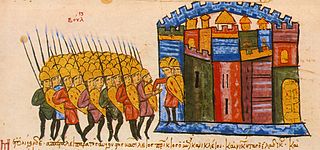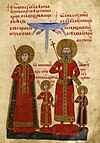| Revision as of 11:49, 10 December 2009 edit212.183.140.20 (talk)No edit summary← Previous edit | Revision as of 11:52, 10 December 2009 edit undo212.183.140.20 (talk)No edit summaryTag: section blankingNext edit → | ||
| Line 11: | Line 11: | ||
| | doi = | | doi = | ||
| | isbn = 954-427-216-X }}</ref> Some coastal towns such as ] remained in the hands of the ] for most of that period. The castles of the inner mountainous country remained one of the last Bulgarian strongholds to be conquered by the Byzantines in 1018/1019 during the fall of the First Bulgarian Empire. During the Byzantine rule Albania was one of the centres of a ]. The last Bulgarian Emperor to govern the whole territory was ] (1218-1241) but after his successors the Bulgarian rule diminished. | | isbn = 954-427-216-X }}</ref> Some coastal towns such as ] remained in the hands of the ] for most of that period. The castles of the inner mountainous country remained one of the last Bulgarian strongholds to be conquered by the Byzantines in 1018/1019 during the fall of the First Bulgarian Empire. During the Byzantine rule Albania was one of the centres of a ]. The last Bulgarian Emperor to govern the whole territory was ] (1218-1241) but after his successors the Bulgarian rule diminished. | ||
| == First Bulgarian Empire == | |||
| The formation of the Bulgarian state as a coordinated effort of Bulgars and Slavs under Khan ] in 681 determined the political doctrine of the new state — incorporation of the Slavic tribes in the Balkans under the Bulgarian rulers. The major successes over the Byzantines during the reign of ] enabled the Bulgarian expansion to the south-west. In the 840s most of what is now Albania and Macedonia were annexed by Bulgaria ruled by ] and his '']'' (first minister) Isbul.<ref name="pr" /> After the ] in the mid 9th century under Presian's son and successor, ], many towns in southern and eastern Albania such as ], ] or ] became major cultural centres. That area including western Macedonia became the second cultural centre of the Bulgarian Empire under the influence of the ]. That region was known under the name Kutmichevitsa. Around 896 the new and energetic Bulgarian ruler ] seized more than 30 fortresses around ], the only major town in Byzantine hands, but could not take the town itself.<ref>{{cite book | |||
| | last = Andreev | |||
| | first = Yordan | |||
| | authorlink = | |||
| | title = The Bulgarian Khans and Tsars (Balgarskite hanove i tsare, Българските ханове и царе) | |||
| | publisher = Abagar | |||
| | series = | |||
| | page = 94 | |||
| | year = 1996 | |||
| | doi = | |||
| | isbn = 954-427-216-X }}</ref> Dyrrhachium was captured in the second half of the 10th century by Emperor ]. In 996 Samuil appointed the noble Byzantine captive Ashot for governor of the town<ref name="Skylitzes, p. 451">Skylitzes, p. 451.</ref> who later escaped to ]. In 1005 the Byzantines managed to recapture Dyrrhachium after its new governor Chryselios surrendered to the enemy securing the title patrician for his sons.<ref name="Skylitzes, p. 451" /><ref>Ostrogorsky, G. ''History of the Byzantine state'' (''Istorija Vizantije'', ''Исторijа Византиje''), pp. 404-405.</ref> In an attempt to recover following the disastrous defeat of the ] in the ] (1014), Emperor ] launched an attack on Dyrrhachium but was killed in the battle marking the end of the First Empire.<ref>{{cite book | |||
| | last = Andreev | |||
| | first = Yordan | |||
| | authorlink = | |||
| | title = The Bulgarian Khans and Tsars (Balgarskite hanove i tsare, Българските ханове и царе) | |||
| | publisher = Abagar | |||
| | series = | |||
| | page = 133 | |||
| | year = 1996 | |||
| | doi = | |||
| | isbn = 954-427-216-X }}</ref> Resistance in separate fortresses in Albania continued until 1019 led by one of Samuil's generals ]. | |||
| == | |||
| == | == | ||
Revision as of 11:52, 10 December 2009
The territory of modern Albania was part of the Bulgarian Empire during certain periods in the Middle Ages and some parts in what is now eastern Albania were populated and ruled by the Bulgarians for centuries. Most of Albania became part of the First Empire in the early 840s during the reign of Khan Presian. Some coastal towns such as Durrës remained in the hands of the Byzantines for most of that period. The castles of the inner mountainous country remained one of the last Bulgarian strongholds to be conquered by the Byzantines in 1018/1019 during the fall of the First Bulgarian Empire. During the Byzantine rule Albania was one of the centres of a major Bulgarian uprising. The last Bulgarian Emperor to govern the whole territory was Ivan Asen II (1218-1241) but after his successors the Bulgarian rule diminished.
==
References
- Curta, Florin (2006). Southeastern Europe in the Middle Ages, 500-1250. Cambridge Medieval Textbooks. ISBN 0-521-81539-8.
- Fine, Jr, John V.A (1991). The early Medieval Balkans; A critical survey from the sixth to the late twelfth century. The University of Michigan Press. ISBN 0-472-08149-7.
Notes
- Andreev, Yordan (1996). The Bulgarian Khans and Tsars (Balgarskite hanove i tsare, Българските ханове и царе). Abagar. p. 70. ISBN 954-427-216-X.






